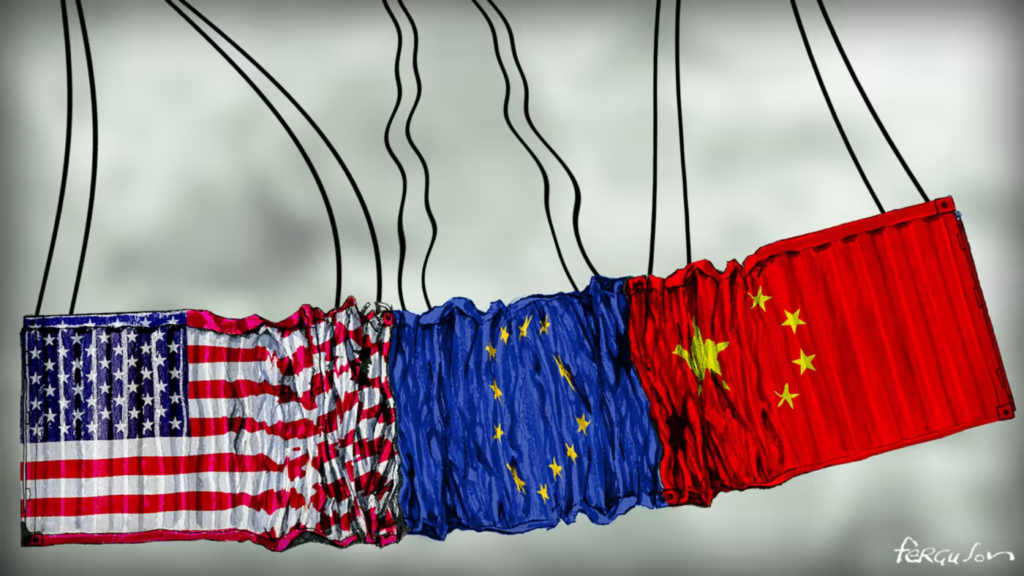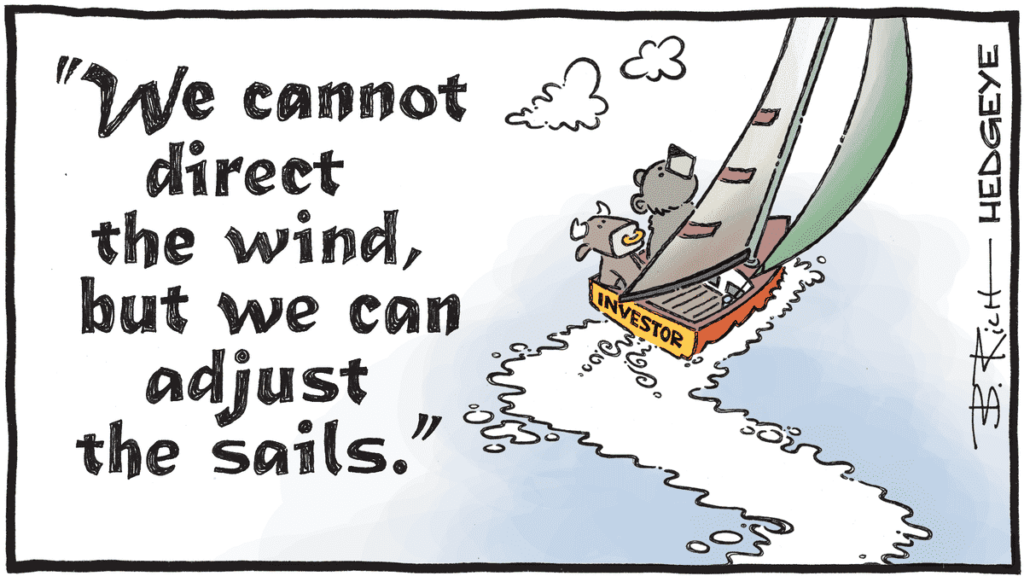
Cleaned out, wiped, liquidated, and erased. That’s how one could describe the performance of the U.S. market since the November election. We’re back to square one, and the S&P 500 has even retested the 200-day moving average for the FIRST time in 16 months! No one is talking about rate cuts to boost the economy anymore; the entire strategy that brought us here is being questioned. And those who believed that Trump would care about stock market performance to justify his record are realizing they were completely mistaken. Yesterday, the mood was grim, but this morning, hope is reborn.
Behind Our Backs
Once again, yesterday’s session was a catch-up session for Europeans. Indeed, the blow that the U.S. market took on Friday evening—when we realized that Trump would no longer negotiate on tariffs—had yet to make its impact felt on European markets. By the time Wall Street had taken its nosedive, we were already home, putting dinner on the table. When it came to Europe catching up, we were not disappointed. If on Monday, EU members were on cloud nine, signing arms deals with the €800 billion announced by Brussels—despite nobody knowing where they’d find a single cent of it, considering that most of the region’s countries are on the brink of financial collapse—things took a drastic turn by Tuesday.
The equation was quite simple: if Trump refused to negotiate with Canada, China, and Mexico, there was absolutely no reason he would do so with Europe. Europe is probably the next in line to get slapped in the face by Washington. But in the meantime, since we all know that Europe is heavily dependent on the health of global trade, we preemptively reacted as if “Trump had just dropped a bomb in front of the European Union offices in Brussels,” attacking anything that might take a hit. The first casualties were car manufacturers, who got absolutely slaughtered—as if they needed that right now—followed by the banks. The “experts” figured that if the tariffs led to a global slowdown, it was inevitable that banks and brokers would suffer the consequences. Banks are the canaries in the coal mine when things improve, but they are also the first to collapse when the economy slows down. And yesterday, we were clearly in “the economy is slowing down, and we’re all going to die” mode. Even the prospect of the ECB cutting rates tomorrow didn’t ease yesterday’s bloodbath.
Awareness, Doubt, and Fear
Looking at the numbers, the most notable event was the DAX finally taking a serious hit. This index, which had resisted everything and set 822 all-time highs in recent weeks, finally cracked. The German index dropped by 3.54%, marking its worst day in over three years—a nice way to welcome the right-wing government to power. And the worst part? Yesterday’s massive drop barely even shows up on the chart. To return to the longer-term trend of the past two years, we would still need to see the index lose another 3,000 points.
In France, the losses were limited to 1.8%, while Italy performed slightly worse than Germany with a 3.41% decline in Milan. Meanwhile, Switzerland held up better thanks to the three heavyweights in the SMI, which all finished in positive territory, keeping the defensive SMI down by only 1.21%—although UBS got absolutely wrecked as fears of an economic slowdown returned.
What’s interesting is how all the bold claims about tariffs being nothing more than a negotiation tactic between Trump and the rest of the world have now gone out the window. Suddenly, everyone is hating Trump for what he’s doing and failing to understand why he’s doing it. But one thing is for sure: these tariffs will make America greater, stronger, better, and Great Again. Honestly, I didn’t study economics much, so I won’t pretend to analyze Donald Trump’s economic doctrines, but let’s just say the market doesn’t buy into them for a second. Confidence in the future is fading fast.
It’s clear that this isn’t an easy market, and the geopolitical uncertainty we’re dealing with right now is anything but simple to navigate, understand, or translate into market behavior.
To sum it up:
- If you were a car manufacturer yesterday, you had a hell of a bad day.
- If you were a supplier selling parts to those manufacturers, it was even worse.
- For a brief moment, in Europe, we stopped talking about World War III, about the €800 billion rearmament plan, and even Rheinmetall was down.
Speaking of that European Union defense loan, I’d love to know how they plan to raise that kind of money. Considering their credibility is about as solid as a corrupt politician in a Banana Republic, and von der Leyen has about as much trustworthiness as a Colombian drug trafficker caught behind the wheel of a 30-ton truck loaded with coke—claiming it wasn’t his truck and that he was just helping a friend—I have my doubts.
Honestly, if you gave me the choice between lending money for Europe’s rearmament or smashing my own kneecaps with a hammer, I’d be heading straight to the garage for that hammer.
But that’s not the point. Yesterday, we didn’t talk about the war in Ukraine, we didn’t talk about armed forces—we simply realized that these tariffs are no joke. It was a massacre. But, as always, there is hope.
Looking Back
Over in the U.S., things weren’t necessarily better, but they were “less bad.” The concerns were the same:
- Worries about the impact of tariffs
- Anxiety over the 100,000 federal employees Trump wants to fire
- Nervousness as Canada, China, and Mexico all announced retaliatory measures against Trump’s decisions
In this environment, the market reaction was essentially the same as in Europe:
- Car stocks got hammered, especially those with factories in Mexico
- Banks took a beating because if the economy slows, financial transactions decrease, and banks make less money
We might be jumping the gun on economic cycles, but since we’re all “visionaries,” we won’t miss the opportunity to get ahead of things.
Take the rate cut expectations, for example. Since October 2023, markets have been rallying in anticipation of multiple Fed rate cuts—and they weren’t wrong. We saw it coming.
Okay, fine, we didn’t get the 12 rate cuts that some “experts” promised in 2024—but let’s be real, three rate cuts still count as multiple!
And among those three, one was a 50-basis-point cut, so technically, that’s four rate cuts… if you think about it.

But hey, that’s not the point.
Yesterday, we were worried because the actions of “Agent Orange” were starting to scare everyone, and we were thinking that he was fully capable of dragging us into a recession. However, TWO things more or less saved the day. One happened during the session, and the other just after.
As for the first thing that saved us, the S&P 500 stopped dropping the moment it hit the 200-day moving average. The rebound was almost surgical. Down to the exact point, the S&P 500 bounced back like a bullet in the opposite direction. And on the Nasdaq side, we managed to avoid entering the “correction zone”—meaning a drop of more than 10% from the highs. At that precise moment, we bounced back, significantly limiting the damage on big tech stocks and the Magnificent Seven.
To put it simply, the market looked terrible, but by 10:00 PM, at closing, it looked a lot less terrible than it had two hours earlier. One thing is certain: markets are more volatile than they have been in a while. The Greed and Fear Index even hit 15… It’s been a long time since we’ve been this scared. The S&P 500 hadn’t touched its 200-day moving average since… well, what a coincidence… since the FED PIVOT in October 2023!
The Sum of All Fears and the Sum of All Joys
And then, after all that, after all those fears, we still got a rescue after the close.
Yes, because after the closing bell, there was an interview on FOX News. An interview with Lutnick, the U.S. Secretary of Commerce, who said that Trump would “PROBABLY” renegotiate tariffs with Canada, Mexico, and China in the coming days—or even hours. Boom! Futures shot up like magic, and this morning, Asian markets are celebrating.
- The Nikkei is up 0.4%, just like China.
- Hong Kong is up 1.6%.
- Oil is at $67.66—still in the danger zone.
- Gold is climbing back to $2,921, aiming for $3,000.
- Bitcoin is at $87,000, and no one likes cryptos anymore.
For now
And then, Trump just finished his speech before Congress.
I’ll skip over the foreign policy part and the usual “Biden is an idiot” rhetoric, along with how everything wrong in the U.S. is the fault of the former president (classic). But Trump defended his new tariff policies, despite market panic. He admitted to a “small disruption” but insisted that it’s worth it to ‘Make America Rich and Great Again.’
Economists are warning that prices will rise for consumers, but Trump insists that other countries will pay, not Americans.
During his speech, Trump did not even mention the possibility of renegotiating tariffs, as Lutnick had suggested just a few hours earlier.
So? Rebound or no rebound? Flash in the pan or real turnaround? That is the question!
A Few More Notes
Beyond that, well… there’s not much else.
- Walgreens is up more than 5% on rumors of a buyout by Sycamore Capital.
- Tesla got wrecked again last night. Not because of the Mexico factory, but because sales in China are collapsing, and Bank of America has downgraded its price targets. Turns out, Musk is losing friends by treating everyone like fools.
Other than tariffs, we should note:
- China has set a 5% growth target for 2025 and is increasing its military budget by 7.2% to “ensure its protection”—you know, in case Taiwan tries to attack them.
- A 5% growth target also means stimulus measures are coming.
And regarding the war in Ukraine, Zelensky is willing to negotiate peace, sign a rare metals deal with the U.S., and do whatever it takes to mend relations with Washington. Maybe everything—except wear a tie.
So, overall, there’s not much exciting fundamental news, and everyone is trying to interpret Trump’s decisions and their consequences. And the week isn’t even over:
- Today, we’ll get the Swiss CPI—which, I’m sure, will “completely change” the face of the markets (sarcasm, obviously).
- There will be ISM data in the U.S. to gauge the economy’s health.
- The Beige Book, oil inventories, and ADP employment numbers are also coming.
Right now, markets are betting on Trump’s potential tariff renegotiation. If it happens, everything we worried about yesterday might have been for nothing.

